
Asteroids is a space-themed multidirectional shooter arcade video game designed by Lyle Rains and Ed Logg released in November 1979 by Atari, Inc. The player controls a single spaceship in an asteroid field which is periodically traversed by flying saucers. The object of the game is to shoot and destroy the asteroids and saucers, while not colliding with either, or being hit by the saucers' counter-fire. The game becomes harder as the number of asteroids increases.
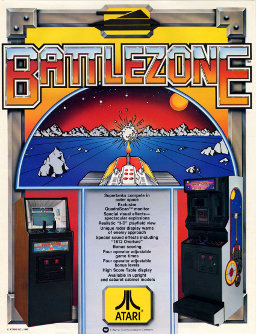
Battlezone is a first-person shooter tank combat game released for arcades in November 1980 by Atari, Inc. The player controls a tank which is attacked by other tanks and missiles. Using a small radar scanner along with the terrain window, the player can locate enemies and obstacles around them in the barren landscape. Its innovative use of 3D graphics made it a huge hit, with approximately 15,000 cabinets sold.

Defender is a horizontally scrolling shooter developed by Williams Electronics in 1980 and released as an arcade video game in 1981. The game is set on either an unnamed planet or city where the player must defeat waves of invading aliens while protecting astronauts. Development was led by Eugene Jarvis, a pinball programmer at Williams; Defender was Jarvis's first video game project and drew inspiration from Space Invaders and Asteroids. Defender was demonstrated in late 1980, before entering production in early 1981. It was distributed in Japan by Taito.
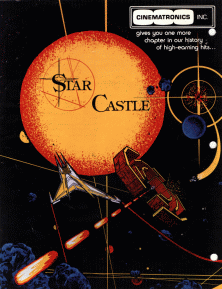
Star Castle is a vector graphics multidirectional shooter released in arcades by Cinematronics in 1980. The game involves obliterating a series of defenses orbiting a stationary turret in the center of the screen. The display is black and white with the colors of the rings and screen provided by a transparent plastic screen overlay.

Robotron: 2084 is a multidirectional shooter developed by Eugene Jarvis and Larry DeMar of Vid Kidz and released in arcades by Williams Electronics in 1982. The game is set in the year 2084 in a fictional world where robots have turned against humans in a cybernetic revolt. The aim is to defeat endless waves of robots, rescue surviving humans, and earn as many points as possible.

Gravitar is a color vector graphics multidirectional shooter arcade video game released by Atari, Inc. in 1982. Using the same "rotate-and-thrust" controls as Asteroids and Space Duel, the game was known for its high level of difficulty. It was the first of over twenty games Mike Hally designed and produced for Atari. The main programmer was Rich Adam and the cabinet art was designed by Brad Chaboya. Over 5,427 cabinets were produced. An Atari 2600 version by Dan Hitchens was published by Atari in 1983.
Fueled by the previous year's release of the colorful and appealing Pac-Man, the audience for arcade video games in 1981 became much wider. Pac-Man influenced maze games began appearing in arcades and on home systems. Pac-Man was the highest grossing video game for the second year in a row. Nintendo's Donkey Kong defined the platform game genre, while Konami's Scramble established scrolling shooters. The lesser known Jump Bug combined the two concepts into both the first scrolling platform game and the first platform shooter. Other arcade hits released in 1981 include Defender, Frogger, and the Galaxian sequel Galaga.
1980 saw the release of a number of games with influential concepts, including Pac-Man, Battlezone, Crazy Climber, Mystery House, Missile Command, Phoenix, Rally-X, Space Panic, Stratovox, Zork, Adventure, and Olympic Decathlon. The year's highest-grossing video game was Namco's arcade game Pac-Man, while the best-selling home system was Nintendo's Game & Watch. The Atari VCS also grew in popularity with a port of Space Invaders and support from new third-party developer Activision.

Mine Storm is a multidirectional shooter similar to Atari, Inc.'s 1979 Asteroids arcade game. Designed and programmed by John Hall, it was published in 1982 by General Consumer Electronics as the built-in game for the Vectrex system. Although not provided on a physical cartridge, a Mine Storm screen overlay and manual were included with each system to support the built-in game.

Asteroids Deluxe is a multidirectional shooter arcade video game with monochrome vector graphics released in April 1981 by Atari, Inc. It is the sequel to Asteroids and was designed to combat the saucer-hunting strategy of the original allowing experts to play for extended periods. These modifications made it significantly more difficult and less accessible to players. Ports of Asteroids Deluxe were released for the BBC Micro in 1984 and the Atari ST in 1987.
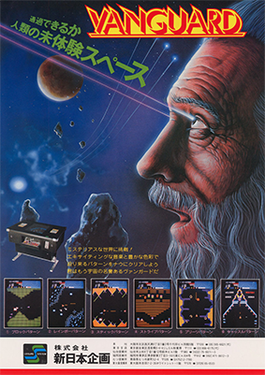
Vanguard is a scrolling shooter arcade video game developed by TOSE. It was released by SNK in Japan and Europe 1981, and licensed to Centuri for manufacture in North America in October and to Zaccaria in Italy the same year. Cinematronics converted the game to cocktail arcade cabinets in North America.

Blasteroids is the third official sequel to the 1979 multidirectional shooter video game, Asteroids. It was developed by Atari Games and released in arcades in 1987. Unlike the previous games, Blasteroids uses raster graphics instead of vector graphics, and has power-ups and a boss.

Crossfire is a multidirectional shooter created by Jay Sullivan for the Apple II and published by On-Line Systems in 1981. Using keyboard-based twin-stick shooter controls, the player maneuvers a ship in a grid-like maze. Versions with joystick-control use the stick for movement and switch to firing mode when the button is held down.

Astro Chase is a multidirectional shooter written by Fernando Herrera for Atari 8-bit computers. It was published by First Star Software in 1982 as the company's first game. Parker Brothers licensed it, releasing cartridge versions for the Atari 8-bit family and Atari 5200 console in 1983 and a Commodore 64 version in 1984. Exidy licensed it for arcade use with its Max-A-Flex cabinet.
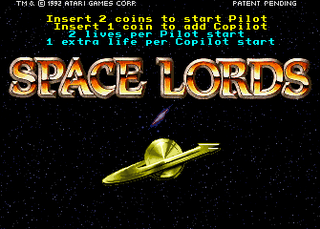
Space Lords is a video game released in arcades by Atari Games in 1992. It is a first-person perspective space combat video game.

In video games, first-person is any graphical perspective rendered from the viewpoint of the player character, or from the inside of a device or vehicle controlled by the player character. It is one of two perspectives used in the vast majority of video games, with the other being third-person, the graphical perspective from outside of any character ; some games such as interactive fiction do not belong to either format.

Space Hawk is a multidirectional shooter released by Mattel for its Intellivision console in 1982. The game is a re-worked version of a previously planned clone of Asteroids in which the player, in a rocket-powered space suit, is drifting in space and shooting down or avoiding targets, including the titular hawks.
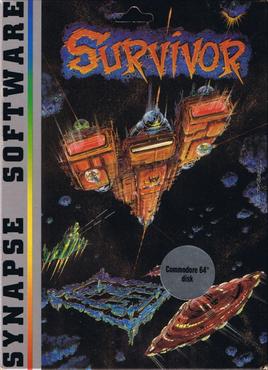
Survivor is a multidirectional scrolling shooter written by Richard Carr for Atari 8-bit computers and published in 1982 by Synapse Software. A Commodore 64 port by Peter Adams was released in 1983.
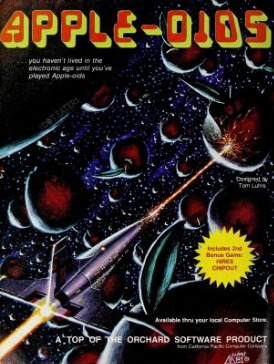
Apple-Oids is a clone of Atari, Inc.'s Asteroids arcade video game. It was written by Tom Luhrs for the Apple II and published by California Pacific Computer Company in 1980. The asteroids in Apple-oids are in the shape of apples.

Threshold is a space-themed fixed shooter written by Warren Schwader and Ken Williams for the Apple II and published by On-Line Systems in 1981. Inspired by Sega's Astro Blaster arcade video game, Threshold introduces many enemy ship types and wave formations as the game progresses. Reviewers found the variety distinguished the game from the many similar shoot 'em ups.


















